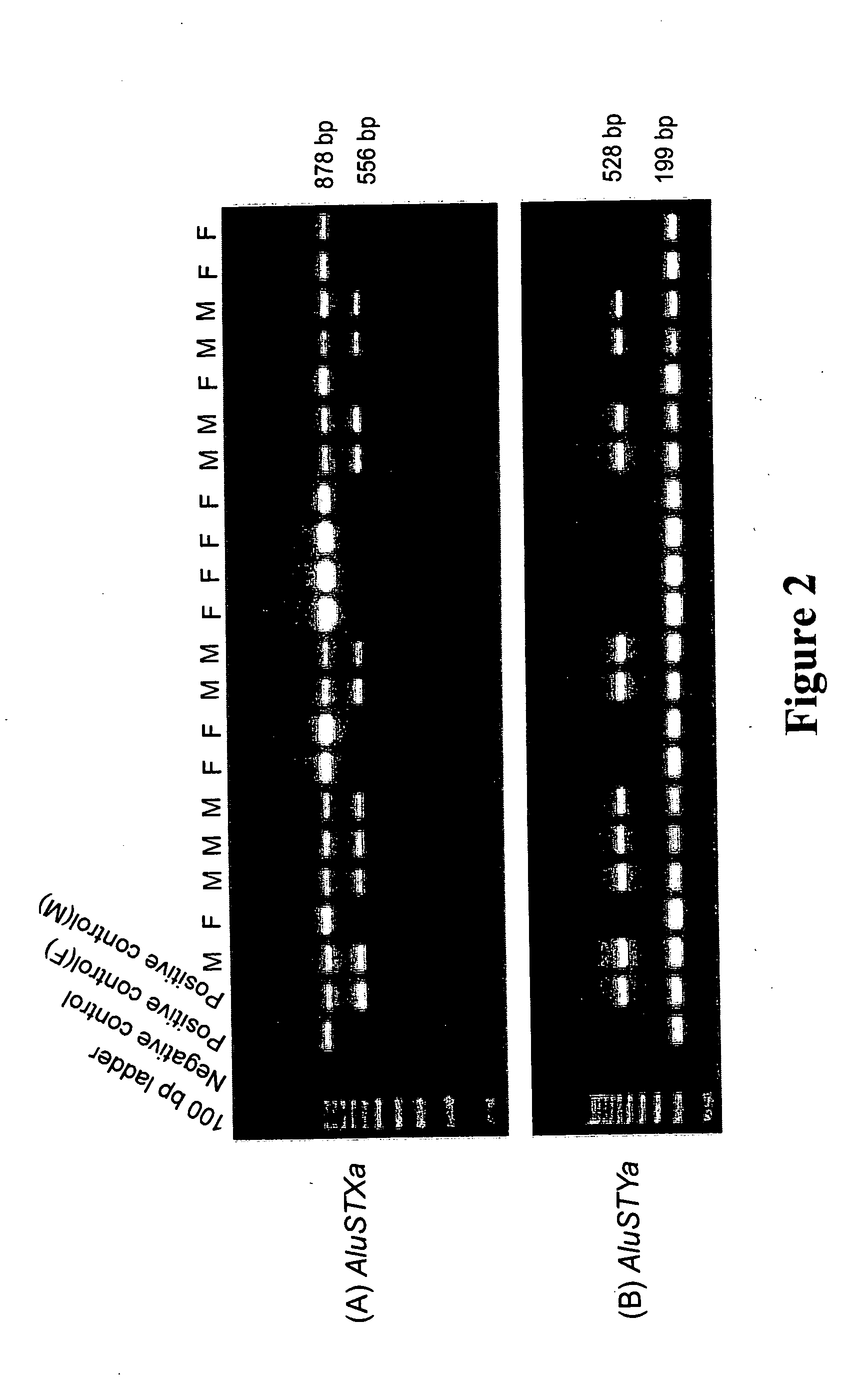Assay for human DNA for gender determination
a human dna and gender technology, applied in the field of gender determination, can solve the problems of reducing the possibility of error, unable to reliably amplify relatively small dna segments, and each of the current approaches has limitations, so as to reduce the possibility of error
- Summary
- Abstract
- Description
- Claims
- Application Information
AI Technical Summary
Benefits of technology
Problems solved by technology
Method used
Image
Examples
example 1
[0041] Stock primers were reconstituted in sterile TLE to a concentration of 100 μM. Then 1 ml of working solution of each primer at 2 μM was made by diluting 20 l of each stock with 980 μl of TLE. This represents a 10× working concentration of each primer. PCR reagents were prepared on ice. 5 μl of DNA template (at 5 ng / μl) or controls was pipetted into each appropriate well. Then a master mix of all remaining PCR reagents was prepared. (See Table 1). 20 μl of master mix was pipetted into each well to make a final PCR reaction volume of 25 μl. PCR tubes or a plate were inserted into a thermal cycler.
TABLE 1volumeexampleusedfor 20Final concentration of PCR reagents:(μl)samplesPCR buffer (10×)1×2.550Forward primer:0.2 μM2.550Reverse primer:0.2 μM2.550dNTPs:200 μM each0.24MgCl2:1.5 mM1.530Cresol red based dye (see supplies and solutions)2.550Taq ®DNA polymerase:1 unit (i.e. 5 U / μl)0.24Sterile water:balance to 20 μl reaction volume162Final volume (20 μl × 20 samples) =400
[0042] PCR p...
example 2
Forensic Assay
[0043] The DNA from the source of blood, saliva, semen, and other tissues found at a crime scene was extracted by standard methods. The extracted DNA was then amplified for two regions AluSTXa and AluSTYa. The reaction mixture for the amplification for the AluSTXa region was comprised of 25 ng of template DNA, 0.2μM of each oligonucleotide primer specific for AluSTXa region as here in described, 200 μM deoxynucleotide-triphosphates, 1.5 mM MgCl2, 10 mM Tris-HCl (pH 8.4) and Taq®DNA polymerase (1 unit) in 25μl volume and the amplification reaction was performed as follows: initial denaturation of 150 seconds at 94° C., 32 cycles of one minute of denaturation at 94° C., one minute at the 58° C., one minute of extension at 72° C., followed by a final extension at 72° C. for 10 minutes. Similarly, the reaction mixture for the amplification for the AluSTYa region was comprised of 25 ng of template DNA, 0.2 μM of each oligonucleotide primer specific for AluSTYa region, 200 ...
example 3
Fluorescence-Based Assay
[0044] As previously indicated, the inventors' assay can be modified to embody fluorescence-based amplicon detection and quantitative PCR to resolve male and female contributions to sex-mixed samples.
[0045] The quantitation of male DNA in the mixture sample was performed by analysis for AluSTYa. A series of known male DNA samples (also called as standard) are amplified with the unknown sample containing the male DNA. The amount of male DNA in the unknown sample is computed by comparing the intensity of the signal from unknown samples with the intensity of standard male DNA. Alternatively, a calibration curve can be generated from the results for the standard male DNA samples. The quantity of the male DNA in the unknown sample was computed from the calibration curve.
Kits
[0046] It is considered that the scope of the invention extends to kits used to practice the assays of the invention. Thus, it is contemplated that the invention would be exploited by marke...
PUM
| Property | Measurement | Unit |
|---|---|---|
| pH | aaaaa | aaaaa |
| temperature | aaaaa | aaaaa |
| temperature | aaaaa | aaaaa |
Abstract
Description
Claims
Application Information
 Login to View More
Login to View More - R&D
- Intellectual Property
- Life Sciences
- Materials
- Tech Scout
- Unparalleled Data Quality
- Higher Quality Content
- 60% Fewer Hallucinations
Browse by: Latest US Patents, China's latest patents, Technical Efficacy Thesaurus, Application Domain, Technology Topic, Popular Technical Reports.
© 2025 PatSnap. All rights reserved.Legal|Privacy policy|Modern Slavery Act Transparency Statement|Sitemap|About US| Contact US: help@patsnap.com


